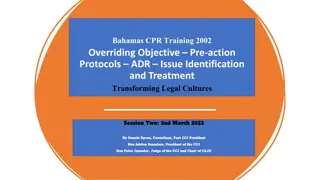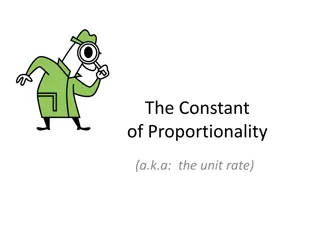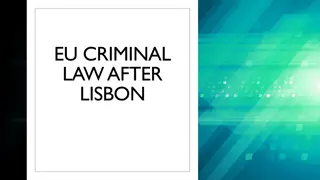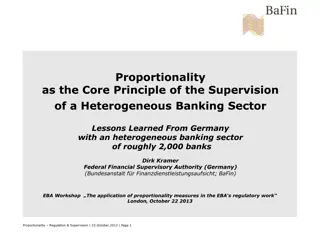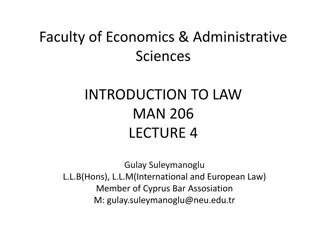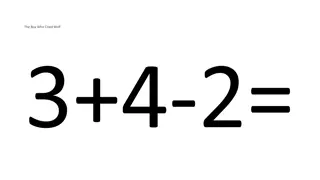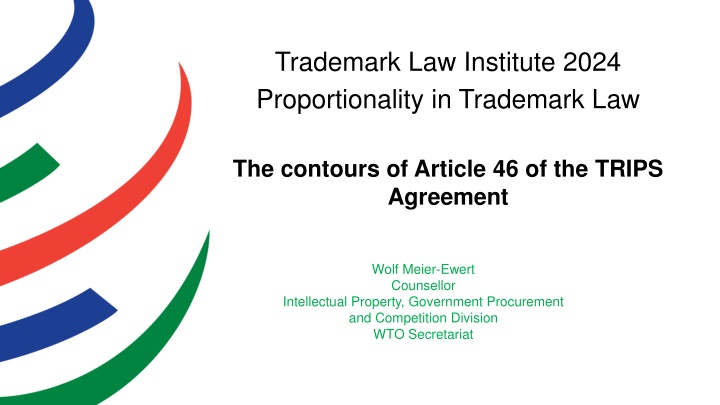
Proportionality in Trademark Law: Understanding Article 46 of TRIPS Agreement
Explore the impact of Article 46 of the TRIPS Agreement on trademark law, focusing on the disposal of infringing goods, judicial authorities' authority to order remedies, proportionality considerations, and the treatment of counterfeit trademark goods.
Uploaded on | 0 Views
Download Presentation

Please find below an Image/Link to download the presentation.
The content on the website is provided AS IS for your information and personal use only. It may not be sold, licensed, or shared on other websites without obtaining consent from the author. If you encounter any issues during the download, it is possible that the publisher has removed the file from their server.
You are allowed to download the files provided on this website for personal or commercial use, subject to the condition that they are used lawfully. All files are the property of their respective owners.
The content on the website is provided AS IS for your information and personal use only. It may not be sold, licensed, or shared on other websites without obtaining consent from the author.
E N D
Presentation Transcript
Trademark Law Institute 2024 Proportionality in Trademark Law The contours of Article 46 of the TRIPS Agreement Wolf Meier-Ewert Counsellor Intellectual Property, Government Procurement and Competition Division WTO Secretariat
TRIPS and the sustainable disposal of infringing goods Article 46 Other Remedies In order to create an effective deterrent to infringement, the judicial authorities shall have the authority to order that goods that they have found to be infringing be, without compensation of any sort, disposed of outside the channels of commerce in such a manner as to avoid any harm caused to the right holder, or, unless this would be contrary to existing constitutional requirements, destroyed. [ ] In considering such requests, the need for proportionality between the seriousness of the infringement and the remedies ordered as well as the interests of third parties shall be taken into account. In regard to counterfeit trademark goods, the simple removal of the trademark unlawfully affixed shall not be sufficient, other than in exceptional cases, to permit release of the goods into the channels of commerce.
Art. 46 and the sustainable disposal of infringing goods China Intellectual Property Rights (DS362): Article 46 is an "empowerment norm requires Members to empower judicial authorities to order such remedies, but not to make such orders in any specific, let alone in all, cases. Article 41 requries that enforcement procedures are "available" in order to "permit effective action" by right owners Remedies required by Article 46 are not exhaustive already clear from 4thsentence context is introduction of at least the most severe remedies where possible not an exhaustive list Proportionality and the interest of third parties Applies to all disposal remedies not just those required by the 1stsentence
Art. 46 and the sustainable disposal of infringing goods The disposal of trademark counterfeit goods In regard to counterfeit trademark goods, the simple removal of the trademark unlawfully affixed shall not be sufficient, other than in exceptional cases, to permit release of the goods into the channels of commerce. Definition of trademark counterfeit goods is more limited than general usage of the term counterfeit "For the purposes of this Agreement: (a) without authorization a trademark which is identical to the trademark validly registered in respect of such goods, or which cannot be distinguished in its essential aspects from such a trademark, and which thereby infringes the rights of the owner of the trademark in question under the law of the country of importation; (Fn 14 to Art. 51 TRIPS) 'counterfeit trademark goods' shall mean any goods, including packaging, bearing
Art. 46 and the sustainable disposal of infringing goods The simple removal of a trademark unlawfully affixed Reflects the concept of counterfeit goods particular to the TRIPS Agreement Where steps are taken, beyond the removal of the infringing sign, that alter the state of the goods so that a simple re-affixation of a trademark would not again result in them constituting counterfeit. other than in exceptional cases where the circumstances suggest that "the simple removal of the trademark would not lead to further infringement" and hence the objective of creating a deterrent does not require further action. application would still need to be remain rare in order to avoid becoming the rule, rather than the exception .
Art. 46 and the sustainable disposal of infringing goods Implications for other remedies: Obligations of the domestic authority ordering the remedy No obligation to carry out the disposal themselves the disposal "outside the channels of commerce" refers to the 'manner' in which the goods are disposed of so that authorities are not responsible for the actions of bodies carrying out the disposal (obligation is phrased in terms of purpose, not result) Conditionality? avoid any harm caused to the right holder only applies to disposal outside the channels of commerce removal of the trademark not necessarily required when disposing of goods outside the cahnnels of commerce.
THANK YOU wolf.meier-ewert@wto.org 7


